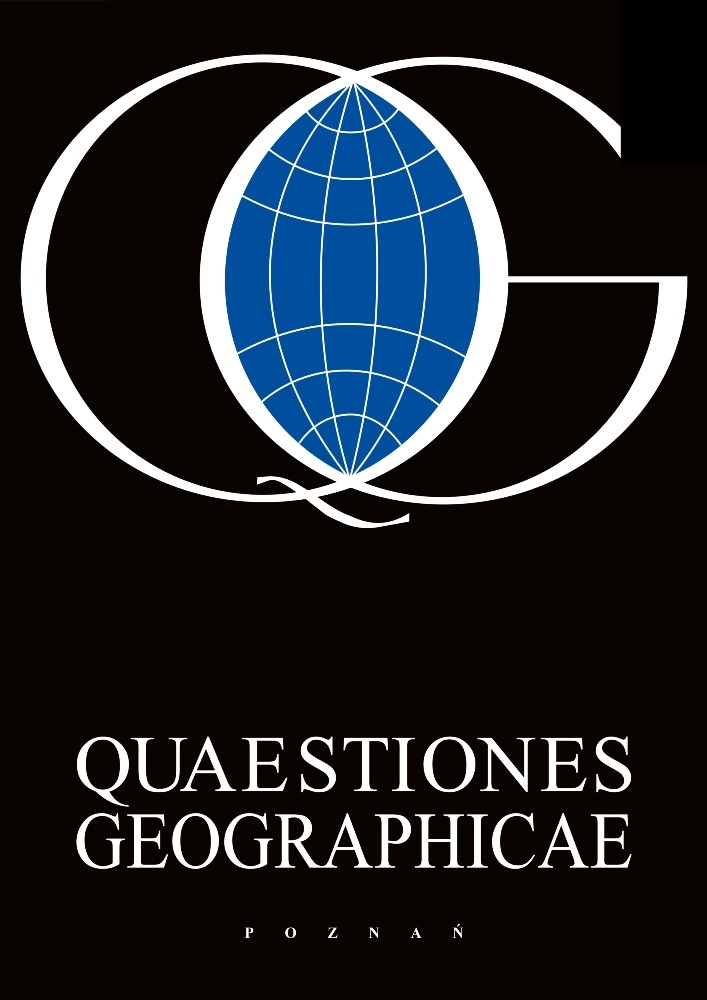Abstract
This article presents an analysis of cartographic materials of the 19th and 20th centuries in terms of changes in the surface water network of the Gardno-Łeba Lowland. The obtained results confirmed that the natural water network was slightly transformed in the first half of the 19th century and considerably increased in the 20th century as a result of agricultural drainage system, especially drainage of wetlands, and river regulations. As a consequence, a hydrographic system with a forced water circulation has developed, that is quite different from the natural. On the one hand, it has become the reason for reversing the proportion in which the groundwater resources have been depleted, along with an increase in the surface water network density, and on the other hand it has caused a change in land use.
References
Cebulak K., 1984. Gospodarka polderowa (Polder management). In. Augustowski B. (ed.) Pobrzeże Pomorskie. GTN, Wydział V Nauk o Ziemi, Wrocław: 229–255.
Chapman S., Buttler A., Francez A.-J., Laggoun-Défarge F., Vasander H., Schloter M., Combe J., Grosvernier Ph., Harms H., Epron D., Gilbert D., Mitchell E., 2003. Exploitation of northern peatlands and biodiversity maintenance: a conflict between economy and ecology. Frontiers in Ecology and the Environment 1: 525–532.
Chlost I., 2010. Kartograficzny zapis zmian sieci wodnej Niziny Gardneńsko-Łebskiej w okresie XIX i XX wieku (Cartographic record of changes in water network of Gardno-Łeba Lowland in 19th and 20th centuries). In. Kaniecki A., Baczyńska A. (eds) Zmiany stosunków wodnych w czasach historycznych. Seria: Studia i Prace z Geografii i Geologii nr 9, Bogucki Wyd. Naukowe, Poznań: 17–31.
Dreyer J. Dr, 1913/14. Die Moore Pommerns, ihre geographische bedingtheit und wirtschaftsgeographische bedeutung (Pomeranian peatbogs, geographic conditions and geo-economic significance), Greifswald: 319.
Cronau C., von 1929, Hinterpommern. Wirtschafts und Kulturaufgaben eines Grenzbezirks (Farther Pomerania. Economic and cultural tasks of the border zone), Gutenberg-Haus, Stettin: 520.
Jankowska M., 1995. Ewolucja informacji o wodach powierzchniowych Poznania w świetle średnioskalowych źródeł kartograficznych z XVIII i XIX wieku (Evolution of information on surface waters of Poznań in the light of medium-scale cartographic sources of the 18th and 19th centuries). In. Kaniecki A., Rotnicka J. (eds) Wody powierzchniowe Poznania. Problemy wodne obszarów miejskich. UAM. Poznań: 47–56.
Jasnowski M., 1990. Torfowiska województwa słupskiego. Stan, zasoby, znaczenie, zasady gospodarowania, ochrona (Peat bogs of the Słupsk Province. State, resources, significance, regulations of use, protection). Akademia Rolnicza w Szczecinie, Wojewódzkie Biuro Planowania Przestrzennego w Słupsku, Szczecin: 84.
Joosten, H., Clarke, D., 2002. The Wise Use of Mires and Peatlands. International Mire Conservation Group and International Peat Society.
Kimmel K., Kull A., Salm J.-O., Mander Ü., 2010, The status, conservation and sustainable use of Estonian wetlands. Wetlands Ecol Manage 18: 375–395.
Kobendzina J., 1976. Z geografii historycznej Łeby i okolicy (Historic geography of Łeba and surroundings). Przegląd Geograficzny 48(4): 689–701.
Kochanowicz G., Hałuzo M., 1992. Ważniejsze elementy rolnictwa wieloprzestrzennego oraz możliwości restrukturyzacji. Wojewódzkie Biuro Planowania Przestrzennego w Słupsku. Słupsk (typescript).
Kucharki L., Stypiński P., 2009, Permanent pasture in agri-environmental programme. Library of Agri-environmental Programme 2007–2013, Warszawa, p. 23.
Lindmajer J., 1981. Przemiany gospodarcze na terenie rejencji koszalińskiej w latach 1850–1914 (Economic transformations within Koszalin administrative region in 1850–1914). Biblioteka Słupska 31. Słupsk-Koszalin: 299.
Malotki M., 1932. Die Entwircklung der Landwirtschaft Hinterpommerns bis zum Ende des 18. Jahrhunderts – unter besonderer Berücksichtigungder durch Friedrich d. Gr. geschaffenen großen Meliorationen (Agriculture development in Farther Pomerania till the end of 18th c., with emphasis on grand meliorations performed under the rule of Frederick the Great), Treptow (Rega): 141.
Mieńko W., Błażuk J., Knitter R., Ziółkowski M., 2002. Plan ochrony rezerwatu krajobrazowego Mierzeja Sarbska na lata 2002–2012. Nadleśnictwo Lębork (typescript).
Pawłat H., 1997. Ocena wpływu na środowisko zagospodarowania złoża torfu Gace-Krakulice w gminie Główczyce, województwo słupskie. Biblioteka SPN (typescript).
Piotrowska H. (ed.), 1997. Przyroda Słowińskiego Parku Narodowego (Nature of the Słowiński National Park). Bogucki Wyd. Nauk., Poznań–Gdańsk: 320.
Rupp H., Meissner R., Leinweber P., 2004. Effects of extensive land use and re-wetting on diffuse phosphorus pollution in fen areas – results from a case study in the Drömling catchment, Germany. Journal of Plant Nutrition and Soil Science 167, 408–416.
Schlechtel A., Dyszak M., Kosierkiewicz S., Schlechtel M., 2004. Operat ekosystemów leśnych. Tom VIII. Plan ochrony Słowińskiego Parku Narodowego. Jeleniogórskie Biuro Planowania i projektowania. Biblioteka SPN (typescript).
Stelmachowska B., 1963. Słowińcy i ich kultura (The Słowińcy ethnic group and their culture). Biblioteka Słupska 11. Poznań–Słupsk: 154.
Szalewska E., 1984. Ewolucja struktury przestrzennej obszaru Słowińskiego Parku Narodowego wraz z obszarem bezpośredniej strefy ochronnej w latach 1880–1990. Praca doktorska wykonana w Katedrze Urbanistyki i Planowania Regionalnego Wydziału Architektury Politechniki Gdańskiej, Gdańsk (typescript).
Szopowski Z., 1962. Małe Porty Pomorza Zachodniego w okresie do drugiej wojny światowej (Small ports of Western Pomerania before Second World War). IBW PAN Gdańsk, PWN, Warszawa-Poznań: 394.
Szuflita K., 1969, Rozwój rolnictwa (Agriculture development). In. Podoski K. (ed.). Z najnowszych dziejów Słupska i ziemi słupskiej 1945–1965. Biblioteka Słupska 20. Poznań: 247–269.
Wild U., 1997. Renaturierung entwässerter Niedermoore am Beispiel des Donaumooses bei ingolstadt: Veggetations-entwicklung und Stoffhaushalt, Ph.D. Thesis, Institut für Landespflege und Botanik, Lehrstuhl für Vegetationökologie der TU München, Herbert Utz Verlag Wissenschaft München, Germany.
License
© 2015 Faculty of Geographical and Geological Sciences, Adam Mickiewicz University.
This work is licensed under the Creative Commons Attribution-NonCommercial-NoDerivatives 3.0 License.
